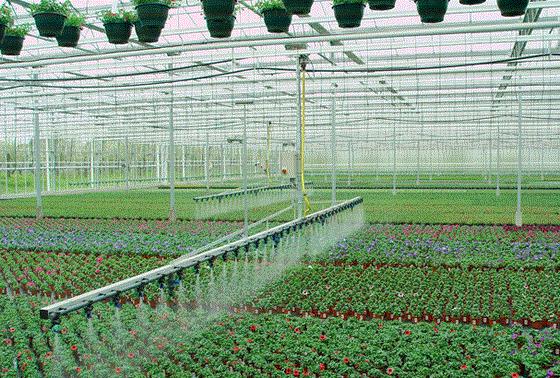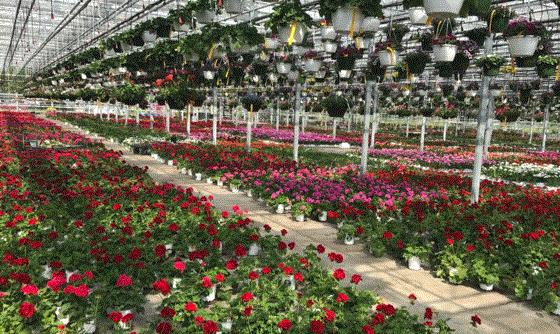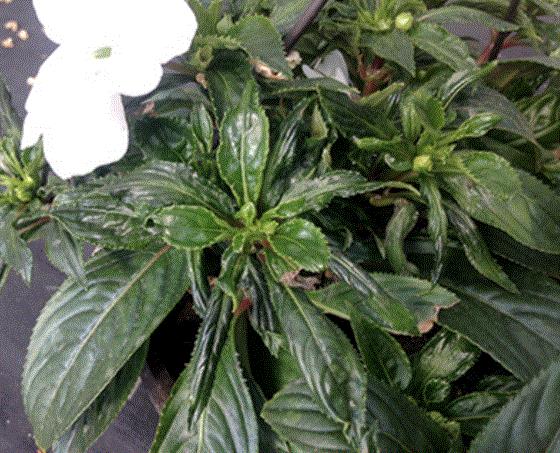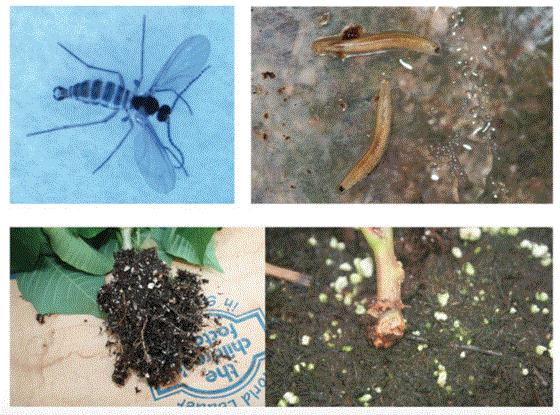Water Management—STEM Podcast Rewinds
This content is by far the most viewed and listened to information we’ve shared via Tech On Demand—water management. This is probably because it’s a topic that impacts every single person who works with plants, but I also think it’s one of the most critical and confusing. The good thing is when you and the rest of your production team get on the same page and starts developing consistent protocols related to irrigation, amazing results are quickly realized.
You may or may not beware that before we launched the Tech On Demand podcast, brought to you by GrowerTalks, I hosted another one called STEM: Insider Tips for Greenhouse Pros. It was fairly early in the whole universe of podcasting, and although the technology was different (old school mic, Skype, all sorts of file converting …) the topics were important, and the guests were top-notch.
I decided that although the old cast is still available on some apps, it’s sort of difficult to find and might not be on your playlist. I’m going to go back to the original audio files, clean them up a bit, and release them as “rewinds” for the current podcast. Starting with … a two-part episode on water management with our buddy Dr. Will Healy.

In THE LANGUAGE OF WATERING, Will helps us understand why speaking the same language of watering throughout the company is critical and how there are qualitative and quantitative ways to teach water management so accuracy and efficiency can be achieved. Getting watering right will reduce your losses and result in better crops.
For the second part, WATERING … THE REST OF THE STORY, Dr. Healy takes it to the next level getting into specific plant demands, how to determine wet/dry targets, how to optimize any greenhouse for water management and even suggests an inexpensive gift for your greenhouse team.
These two episodes AND 120+ MORE can be found on SPOTIFY, APPLE PODCASTS and just about any other podcast platform you use. Be sure to subscribe so you never miss an episode and if you have a minute to leave a positive review, it will be greatly appreciated!

Nick’s Tip of the Week: Spring Bedding Plant Catch-Up or Tone-Down (Part 2)
Each week, I’ll work with my buddy Nick Flax, a technical services expert at Ball, to share a concern that’s come up during one of his numerous calls with growers across North America. This week he’s addressing some issues that he’s been helping growers with lately—pushing or slowing down crops to hit retail ship dates. This will be broken into two parts with the push covered last week and the slow down covered below.
PROBLEM: If the wacky weather this spring has gotten your spring bedding plants all out of sorts, keep reading. Last week I covered BMPs to get crops that have fallen behind caught up. Check it out HERE if you missed it. This week, we’ll jump right back into it with suggestions on how to slow down and tone crops that filled out too quickly.

NICK’S TIP: As I mentioned last week, finished crops should generally be about two to three times the height of their finished containers. While it’s challenging to push crops when the weather has been uncooperative, it’s literally impossible to un-grow shoots and leaves. If some of your crops are too far ahead of schedule, use the following strategies to slow them down and tone them before finish.
Catch “jumps” quickly and act early. You should walk your crops daily or every other day, at least. Note which crops or varieties have sized-up quicker than you’d like so you can take gentler steps to check excessive growth.
-
A simple way to keep track of this easily is to use two different-colored flags—one for when the crop is about 50% of the desired finished size and another for about 75%.
-
A better way to do this is to place a “group info tag” at the beginning of each new program or planting. Use a permanent marker to write out guidelines for that crop’s finished spec and jot down culture notes like the planting week, ship or finish week, fertilizer applications, and pesticides or PGRs applied. This will help you decide if you need to slow a crop down and how urgently to respond.
Reduce temperature. The rate of development (leaf unfolding, bud development, etc.) in plants is heavily controlled by temperature. Whenever possible, lower greenhouse temps to the lowest safe temperature for your crops to check excessive growth.
-
This is not always possible when unseasonal weather occurs. However, you can do things like manage DIF (day temp – night temp), despite warm temps outside. The closer your DIF value is to zero, the less crops’ internodes will elongate.
-
Don’t forget to use the morning DROP strategy when possible. Lower air temperature 5 to 10 F below your normal target air temp for two hours before and two hours after sunrise (4 hours total) to help further suppress internode stretch.
Restrict water. No matter how uncooperative the weather is, you can always water less. It can be difficult for less-experienced growers to run soil on the dry side, but this is a critical skill to develop if you want to keep crops on track and not overgrown.
-
Make sure crops are watered thoroughly (all the way to the bottom) but infrequently and avoid soil moisture above a level 4 on the 1–5 water level scale (1=air dry; 5=saturated).
-
Pick pots and flats up to feel how much moisture is in the media—don’t base irrigation decisions off the color of the soil at the top of containers.
-
Before you water, sample a few containers from the group (avoid pots on the corners and edges). Flip them over, pull the pots off and look at the distribution of moisture to ensure media has thoroughly dried from top to bottom.
Restrict fertilizer. If moisture management alone isn’t enough to check growth, reduce the amount of fertilizer you apply. Plants don’t get full after eating the way people do, and they will continue to take up excess fertilizer salts in the media. This encourages excess, lush growth, so it’s important to monitor substrate electrical conductivity (EC; measure of soluble salts in the media) and adjust production practices to avoid salt buildup.
-
If you run constant liquid feed (CLF; feed every time you water) approach, start with a clear water leach to flush out built-up fertilizer salts. For example, if you normally run CLF at 200 ppm nitrogen (N), leach the crop with clear water to flush excess salts and resume CLF at a 100 to 150 ppm N.
-
If you use the periodic/cyclical feed approach (alternate between fertilizer at about 300 ppm N and clear water), leach the crop thoroughly with clear water. Then, reduce fertilizer concentration to 200 ppm N or apply clear water twice after each fertilizer application of 300 ppm N.
-
The key to success when you withhold fertilizer is to ride the line between “not enough” and “just enough” mineral nutrients. However, be sure to not overdo it and induce a slew of mineral nutrient deficiencies—particularly when it comes to micronutrients. When you reduce fertilizer concentration to about 100 ppm N from a complete, 1-bag blend, this often does not provide enough micronutrients to mature plants. It’s advisable to periodically supplement a lean crop with a micronutrient package like STEM (soluble trace elements mixture) or MOST (mix of soluble traces) to combat this.
-
Some fertilizer manufacturers produce incomplete fertilizers like 0–7–5 “holding blends,” which provide all the mineral nutrients plants need except N. They are rarely advertised as part of manufacturers’ normal product lines, but you may want to ask your supplier if they can get a hold of something like this. These blends are great tools to have in your grower toolbox and can be very helpful if you need to hold a crop. It allows you to completely withhold N to discourage lush growth but eliminate the risk of other macro- or micronutrient deficiencies.
Use PGRs as a last resort. Many growers are quick to grab the sprayer when crops start to jump. Don’t get me wrong—PGRs are great and can be powerful tools to help us steer crop growth in a pinch. However, good crop tone is best achieved through diligent stewardship of water and fertilizer and light use of PGRs, when needed.
-
If you need to use PGRs, it’s best to apply them early and at low concentrations. Oftentimes, using PGRs at high concentrations late in the crop cycle can change leaf shape, size and color drastically, delay or slow flower development and affect garden performance for consumers.
-
There is no one-size-fits-all approach to using PGRs effectively. Some active ingredients are more potent than others and some simply do not work on certain crops. Look to resources like the GrowerTalks Annual PGR Guide and Perennial PGR Guide for high-level info and spray or drench rate suggestions.
-
For crop-specific PGR suggestions, look to culture sheets provided by plant breeding companies through your young plant supplier. These often have series- or variety-specific suggestions for PGR active ingredients and appropriate concentrations to apply to achieve ideal growth restriction.

Beware of Broad Mites
Hopefully you aren’t battling broad mites at the moment, but we’ve heard enough reports and gotten plenty of calls from growers already this season that chances are, you might be (or will soon). The experts at Michigan State University published an excellent two-part article covering this common pest from beginning (identification) to end (control).

In PART 1: CHALLENGES AND TREATMENTS, the researchers ask the question, “Why are broad mites so concerning?” There are a couple of answers they share:
Broad mites are concerning because they are microscopic and are very difficult to see with the common 5x to 10x hand lens. You must send samples to a diagnostic lab for a positive diagnosis.
Greenhouse scouts and growers usually notice the plant damage after the populations are already very high and the crops are unsalable. Oftentimes, the damage to the upper leaves near the apical meristem is only noticeable 20 to 30 days after they began infesting the crop. (And by then, the pests have moved on to the next healthy crop.)
But part one doesn’t stop there. Read the full article for conventional and biological control strategies that have proven effective for combatting this destructive mite.
The second part dives deeper into SCOUTING AND SAMPLING for broad mites in ornamental crops. One specific scouting strategy is detailed—dipping plant shoots in alcohol, pouring the solution onto filter paper and examining under a microscope to spot broad mites.
But many of you might not want to use this process and prefer moving right to chemical controls when broad mite damage is detected. Our friends at MSU suggest using a recommended miticide when you start to see broad mite damage. Leave a couple of plants untreated and compare the treated and untreated plants. If the untreated plants continue to get worse and the treated plants do not, growers likely have broad mites.
Your best bet (as is usually the case with crop issues that could be easily misdiagnosed) is to send plants to your preferred diagnostic lab for an expert evaluation.
Be sure to read the full stories linked above because I only briefly summarized the detailed info.

Stay Vigilant for Fungus Gnats
The Tech On Demand team has heard plenty of reports of fungus gnats this season (not uncommon this time of year) and I wanted to share a fantastic article written by insect and mite pest guru Dr. Ray Cloyd that ran in GrowerTalks in 2022.

In A CONSTANT SCOURGE, Dr. Cloyd shares just about everything you need to know about fungus gnats in a useful and understandable way. Instead of trying to paraphrase him, I’ll share a short excerpt and recommend you read the full article (and bookmark it for future reference).
Fungus gnats, Bradysia spp., are insect pests of greenhouse-grown horticultural crops and are one of the few insect pests where the damaging life stage—larvae—is located in the growing medium. Fungus gnat larvae cause plant damage under moist conditions when plants are young. Fungus gnat adults don’t cause plant damage but can be a nuisance when flying around. Adult females lay eggs in the growing medium. The larvae that emerge from the eggs cause direct plant damage when feeding on the roots.
Damage. Fungus gnat larvae direct feeding damages developing root systems, which interferes with the ability of plants to uptake water and nutrients. Direct damage results in stunted plant growth and wilting. Larvae can also cause indirect damage during feeding by predisposing plants to infection from soil-borne diseases by creating wounds that allow entry of soil-borne plant-pathogenic fungi.
After covering the basics, Dr. Cloyd gets into the nitty gritty—control strategies including cultural/environmental management and chemical and biocontrol solutions.

Finish Line … I’m at CAST: Follow Along!
Last week, I ended with a reminder to connect with all of the resources and social channels where the Ball Publishing “Bobblehead” California Spring Trials crew will cover and share what we’re seeing out west. Well, by the time you’re reading this newsletter, we’ve been on the road for three full days and visited about 75% of the CAST tour stops.

I hope you’ve been following along with the daily Acres of buZZ! newsletter, videos and social posts! If not, that’s OK because it’s all saved and available to check out at your leisure. Below are all the links you need.
WATCH OUR DAILY VIDEOS on the GrowerTalks YouTube channel. We shoot them live at each trial location and post them later that night.
READ OUR DAILY NEWSLETTER COVERAGE, which should hit your inbox in the middle of the night following each day we’re on the road. Sign up by clicking the link.
FOLLOW US ON INSTAGRAM for pretty plant pics—@growertalksgreenprofit
FOLLOW US ON FACEBOOK for more pretty plant pics, short live videos and some behind-the-scenes shenanigans.
Let me know what catches your eye and looks promising for your product mix in 2025! Next week, I’ll share some of my favorites and anything else I learned from some of the industry’s top breeding companies and the folks I caught up with on the road.
Talk to you soon!





Please feel free to send your comments, constructive criticism and topic ideas to me at bcalkins@ballhort.com.

Bill Calkins
Editor - Tech On Demand
This email was received by you and 25,937 other fine subscribers!
If you're interested in advertising in Tech On Demand, contact Kim Brown ASAP and she'll hook you up.